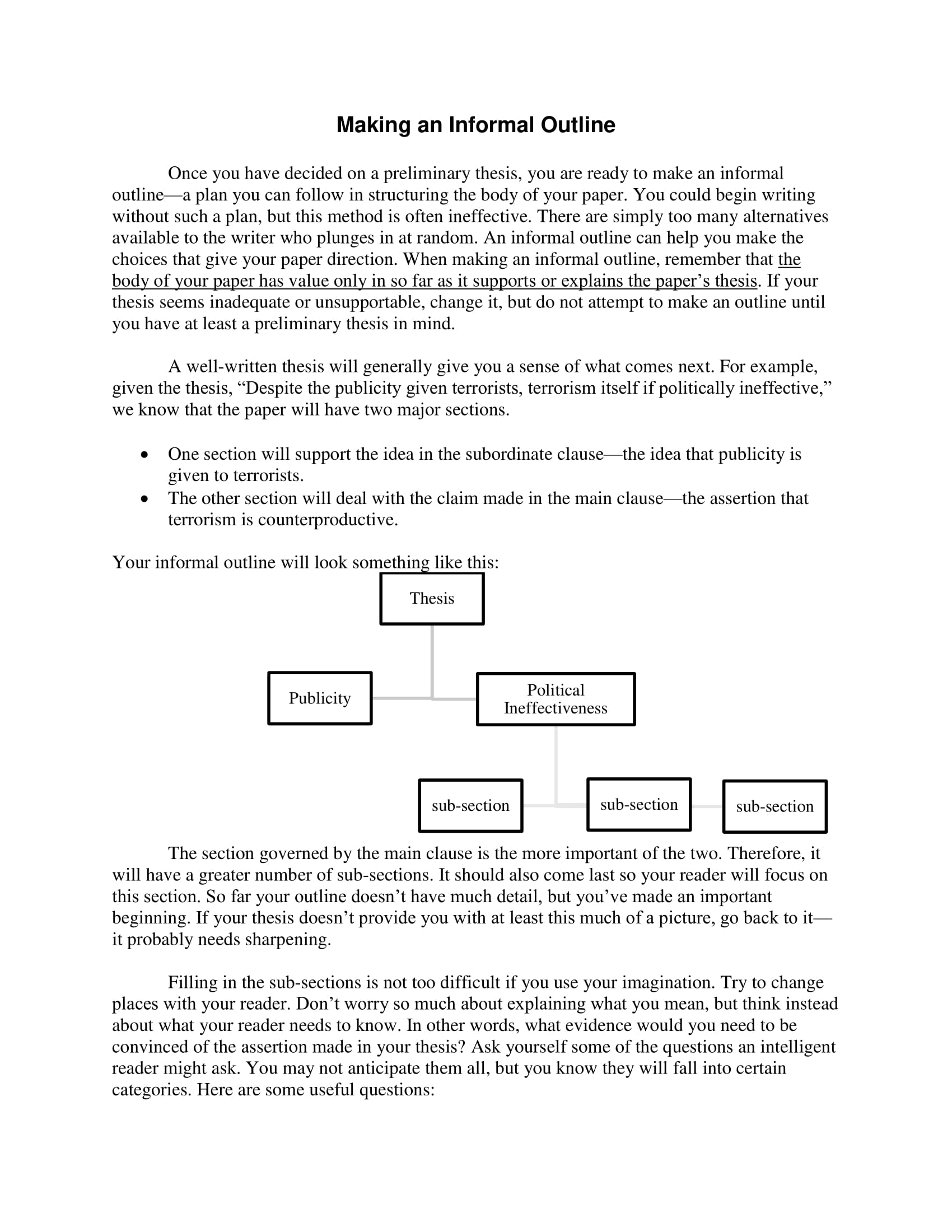Informal Outline Examples to Download
Sometimes during lectures, speakers forget that their listeners want to take notes of what they’re talking about and they tend to ramble on and on and on. Their listeners struggle to write down the facts and information given by the speaker because before they even finish writing the first one, another one is introduced immediately. This results in random writings and incomprehensible words and sentences. You may also see content outline.
Most students do this especially when a PowerPoint presentation is not available. Important information is written in messy handwriting and abbreviated words just to make do with what’s available. This habit has resulted in disorganized and incoherent thoughts. You may also see leadership outline.

Although students try to outline topics discussed by their professors, with the limitations of time, it simply is not ideal and downright near impossible. Outlines are designed to summarize a certain topic and break it into smaller but still understandable parts. They help you organize thoughts and ideas. You may also refer to How to Write Definition Essay and Examples
What is an Informal Outline?
An inform outline sometimes called a scratch outline or working outline is a blueprint for the argument. It still functions like any other outlines, however, it does not have the rigidity of a formal outline. Ideas are listed down minus the roman numerals that segregate main topics from sub-topics. You may also see project proposal outline.
An informal outline can also become the basis for your formal outline. Once you’re done casually listing ideas that support your thesis, you can easily make a complex formal outline. Although this outline is fluid in structure, it is subject to constant revision because it is made with no attention to form and is destined for the trash bin.
Meaning an informal or working outline as the name would suggest is a constant work in progress. The writer just scribbles ideas that he/she thinks best explains the main idea and continues to add more examples to his/her outline. By doing more expansion and correction of his/her ideas, he/she is then able to come close to a rough summary of his/her own paper. You may also see Samples of Formal Essays

How to Make an Informal Outline
As this is an informal outline, there are no strict rules to follow and no structure to adhere to. An informal outline is just normally prepared by you, the writer, it is not rigid and controlling. It is somewhat like a free-flow writing where you jot down additional details as you progress. However, you can still follow these basic steps to have a more understandable informal outline:
1. Write the Title of Your Outline
The title of your outline should directly reflect the title of your actual paper. This will serve as a guide for you as you think and write about the topic. This step serves as the foundation of your thesis and helps ground the ideas you will include. You may also see training outline.
The title of your outline is not necessarily the title of your actual paper but it just a mere reflection of the same thought as your actual title. There are instances that as you continue to write the supporting details of the main topic, you follow a slightly different thought group than you originally planned. In this case, you can always revise the title and make it more suitable to the contents of your outline. Also, see Examples of How to Write a Topic Outline
2. Formulate Your Thesis
Write your thesis clearly and label it as “Thesis.” For example, “Thesis: Environment conservation including the 3 Rs, reforestation, anti-mining drive, plastic use minimization and carbon footprint reduction.” By doing this, you are constantly reminded of the ideas and thought that you will need in your paper. It will give direction to the outline you are trying to make. The thesis is the backbone of your outline and the final paper. The supporting details revolve around the thesis in order to prove or elaborate it. You may also see thesis outline.
3. Write Your Main Idea
There can be more than one main idea on a certain topic. The main idea of your outline is the first issue in your thesis. Like in the given thesis above, your first main idea is about the 3 Rs namely Reduce, Reuse, Recycle. When writing your main idea in an informal outline, there is no need to label it as the first main idea. Unlike in a formal outline, it is not necessary to use roman numerals in an informal outline. You may also see book outline.

4. Write Your Supporting Details
After your main idea comes the supporting details. It is better to indent the beginning of your first supporting detail. In the given example above, your first supporting detail can be “minimizing the use of non-biodegradable housewares.” As there are no rules in an informal outline, you can elaborate on your supporting detail as much as you want with the limitation that an outline is supposed to shorten your paper, not lengthen it much more. You may also see course outline.
Like mentioned before, an informal outline is a free-flowing form of outlining, therefore, as you go through more main ideas and their supporting details, you can also insert new ones that you think is important and relevant to the topic. You may also see resume outline.
After the fourth step, you can add more supporting detail about your first main idea (step 3). After that, you can now add your second main idea. In the thesis given above, it would mean the second main idea is reforestation. You can then add its supporting details. And so on. You may also see Step Basic Guide on Essay Writing.
Making an Informal Outline Example
Things to Remember
1. An informal outline has no correct or incorrect format. It does not follow a number scheme or a hierarchical order. It is in the discretion of the writer how to organize his/her outline. You may also see essay outline.
2. It helps you organize your idea the best way you want it to. You can draw diagrams, draw ideas within bubbles, make charts or anything just to help you get your outline done.
3. As the name implies, a scratch outline only serves as a basis for your formal outline. It is destined to be put in the trash bin after you jot down your ideas, organize and reorganize ideas, and revise it as many times as you want without any restrictions in its format. You may also see speech outline.
4. Even though an informal outline is free-flowing, your outline should still be able to help you identify gaps in your argument, and problems with structure and logic. You may also see news editorial outline.
An informal outline is good to use when you are tasked to write an essay or any writing activity in a limited time. Because of the freedom it provides, you will have no problems just writing down ideas and rearranging them in the order you would like. You may also see program outline.
However, you must be careful about the lapses in an argument or the organization of your ideas. Because it is unstructured by nature, you might forget to arrange your ideas and in return come up with an incoherent paper instead. Always think about the flow and transition of your thoughts when you transfer it in your final paper. You may also see sentence outline.



